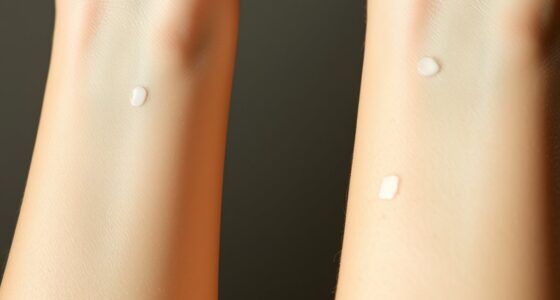To enhance your skin’s radiance, try DIY face masks with kitchen ingredients! Combine turmeric with lemon juice to brighten up your complexion, or use coffee grounds for gentle exfoliation and improved circulation. Mixing honey with avocado offers deep hydration, while soothing aloe vera can calm irritation. For a rejuvenating effect, blend cocoa powder with yogurt. These simple yet effective recipes can bring your skin to life, and there’s so much more to discover for glowing skin!
Key Takeaways
- Combine turmeric and lemon juice for a natural brightening mask that reduces pigmentation and enhances radiance.
- Use coffee grounds as a gentle exfoliant to stimulate circulation and improve skin texture.
- Mix cocoa powder with yogurt to rejuvenate the skin while providing antioxidants for a healthy glow.
- Create a mask with honey and banana for hydration and softness, leaving skin looking radiant.
- Incorporate oatmeal into your mask for its soothing properties, calming irritation and promoting a bright complexion.

When you’re looking to pamper your skin without breaking the bank, DIY face masks are a fantastic option. You can easily whip up effective treatments using ingredients right from your kitchen. These masks not only save you money but also allow you to customize your skincare routine to suit your skin’s unique needs.
For soothing sensitive skin, oatmeal is a great ingredient. Its anti-inflammatory properties help calm irritation, while aloe vera heals and soothes. If you’re dealing with dry skin, honey works wonders as a natural moisturizer. It’s antibacterial too, making it suitable for all skin types. Natural kitchen ingredients can rival over-the-counter products, providing effective solutions for various skin issues. Incorporating essential oils for aromatherapy into your routine can enhance the overall experience, as certain oils like lavender may also help with calming effects on the skin. Additionally, chia seeds are rich in omega-3 fatty acids, which can help reduce skin inflammation.
For those wanting to brighten their complexion, turmeric can be your best friend; its antioxidants help reduce pigmentation and promote an even skin tone. If hydration is your goal, consider making a mask with avocado, which is packed with fatty acids and antioxidants that deeply nourish your skin. Olive oil is another excellent choice, providing moisture and protecting your skin with its rich antioxidants.
Combine these with honey and banana, which exfoliates dead skin cells while keeping your face moisturized. Coconut milk is also fantastic for oily skin, as it hydrates without clogging pores.
For a brightening and exfoliating effect, think about using turmeric mixed with lemon juice. This combo effectively reduces hyperpigmentation and brightens your complexion. You can also incorporate coffee grounds as a natural exfoliant to improve circulation and minimize puffiness.
Cocoa powder, rich in antioxidants, rejuvenates your skin while lemon juice tightens pores and reduces oiliness. Cinnamon can join the mix for gentle exfoliation and added anti-inflammatory benefits.
If you’re struggling with acne-prone skin, strawberries are a secret weapon due to their natural salicylic acid. Pair them with tea tree oil for its antimicrobial properties to enhance the mask’s effectiveness. Egg whites help tighten pores and work effectively with tea tree oil to combat breakouts.
Honey can assist here too, maintaining the antibacterial theme to clear acne-prone skin. Turmeric can help reduce redness associated with inflammation.
Finally, for a hydrating and cooling mask, cucumber is your go-to for replenishing moisture. Aloe vera and avocado provide soothing benefits, while yogurt hydrates and calms irritation. Bananas can add an extra layer of hydration and softness.
With these kitchen ingredients, you can create a range of face masks that cater to your skin’s needs, leaving you radiantly refreshed and rejuvenated.
Frequently Asked Questions
How Often Should I Use DIY Face Masks for Best Results?
To get the best results from DIY face masks, it really depends on your skin type.
If you have normal skin, try using a mask once a week. For dry skin, you can apply it twice a week for added hydration.
Oily skin benefits from weekly use, while sensitive skin should stick to once a week to avoid irritation.
Always listen to your skin and adjust the frequency as needed for optimal results.
Can I Store Leftover DIY Face Mask Mixtures?
Yes, you can store leftover DIY face mask mixtures, but be cautious.
Most fresh masks last only up to a week in the fridge. Always use airtight containers to maintain freshness, and check for any off smells before applying.
For longer storage, consider using dry ingredients and add liquids just before use.
Remember to patch test before using any stored mixture to ensure it’s safe for your skin.
Are There Any Allergens in Common Kitchen Ingredients?
You might think your kitchen’s a safe haven, but it’s a minefield of allergens waiting to explode!
Common ingredients like milk, eggs, soy, wheat, and nuts can wreak havoc on unsuspecting eaters.
Even hidden ingredients can pack a punch, sneaking into foods like sauces and baked goods.
Always read those labels and check for allergens before whipping up your next culinary masterpiece.
Your health deserves that extra caution!
Can These Masks Treat Specific Skin Conditions?
Yes, these masks can treat specific skin conditions effectively.
For acne-prone skin, the turmeric and honey mask reduces inflammation and bacteria.
If you have dry skin, the avocado and banana mask provides deep hydration.
For sensitive skin, the Greek yogurt and cucumber mask calms irritation.
And if you’re looking to brighten your complexion, try the turmeric and lemon mask for exfoliation and radiance.
Choosing the right ingredients can make a significant difference!
Is It Safe to Use These Masks on Sensitive Skin?
Yes, it’s generally safe to use DIY masks on sensitive skin, but you should take precautions.
Always perform a patch test first to check for reactions. Stick to gentle ingredients like aloe vera and oatmeal, and avoid irritants such as citrus or spices.
Limit your use to once or twice a week to prevent irritation. If you have existing skin conditions, it’s wise to consult a dermatologist before trying new masks.
Conclusion
As you blend these simple kitchen ingredients, think of each mask as a brushstroke on the canvas of your skin, revealing the masterpiece beneath. Just like a garden flourishes with care, your complexion will bloom with radiance and vitality. Embrace this ritual, allowing the nourishing elements to transform you, as sunlight transforms a seedling into a vibrant flower. With each application, you’re not just enhancing your beauty; you’re celebrating the art of self-care and the brilliance that lies within.









